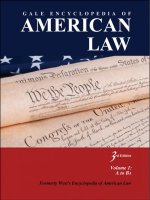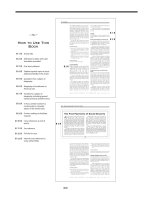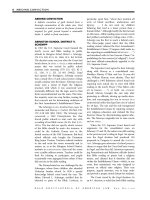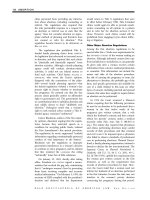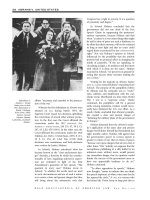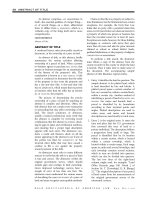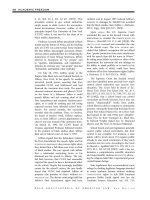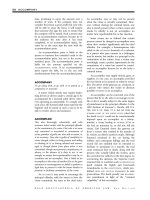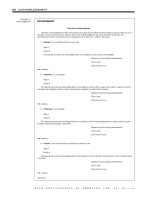Gale Encyclopedia Of American Law 3Rd Edition Volume 1 P17 ppt
Bạn đang xem bản rút gọn của tài liệu. Xem và tải ngay bản đầy đủ của tài liệu tại đây (246.95 KB, 10 trang )
An accidental, casual, secret, or permissive entry
is ineffective. While the entry must be notorious,
it must also be peaceable to prevent violence and
warfare, which might otherwise result.
The payment of
REAL ESTATE taxes by the
owner, while demonstrating that he or she has
not abandoned land, is not considered to have
any impact on continuous possession.
The adverse claimant may destroy his or her
continuous possession by abandoning the land
or giving it to someone else, even the owner,
before the time at which title to it would vest. It
does not matter how long or brief the abandon-
ment is as long as it was intentional. A temporary
absence from the land is not the same as an
abandonment and has no effect on the occupancy,
provided it is for a reasonable period of time.
Statutory Period The time period of the
statute of limitations that must expire before title
can be acquired by adverse possession varies
from state to state. No statute will begin to run
until the adverse claimant actually possesses the
property in question under color of title or claim
of right, where necessary. As of that time, the
landowner is entitled to bring a lawsuit against
the possessor to recover the property.
The adverse possessor must occupy the
property for the full statutory period. In jurisdic-
tions that also require color of title, it must
coexist with possession for the complete period.
If the statute of limitations has been
suspended—for example, because there is a
lawsuit pending between the owner and the
claimant or the owner is insane, an infant, or
serving in the armed services—that amount
of time will not be counted toward the time
necessary for the acquisition of title.
Acquired Title
Once adverse possession is completed, the
claimant has full legal title to the property.
The expiration of the statutory period elim-
inates any
CAUSE OF ACTION or LIABILITY for
ejectment or trespass regarding the new owner’s
prior
UNLAWFUL possession of the property. Once
the time period is satisfied, the adverse posses-
sor is considered the original owner of the land.
He or she may use the land any way he or she
sees fit provided it is lawful.
Personal Property
Ownership of PERSONAL PROPERTY may be ac-
quired by adverse possession if the same
requisites are met. The clai mant must possess
the property actually, openly, notoriously,
exclusively, hostilely, under claim of right, and
uninterrupted for the statutory period.
FURTHER READINGS
Berger, Lawrence. 1999. “Unification of the Doctrines of
Adverse Possession and Practical Location in the
Establishment of Boundaries.” Nebraska Law Review
78 (winter).
Bloch, David S., and James Parton III. 2001. “The Intent
Theory of Extinguishment Under California Law.”
Southwestern Univ. Law Review 30 (winter).
Gonski, Dennis M. 2001. “Disrupting More Than a Half
Century of Accepted Law.” New Jersey Law Journal
(June 18).
Latovick, Paula R. 1998. “Adverse Possession of Municipal
Land: It’s Time to Protect This Valuable Asset.” Univ. of
Michigan Journal of Law Reform 31 (winter).
Spitler, William Hayden. 2000. “Over a Century of Doubt
and Confusion: Adverse Possession in Arkansas, Intent
to Hold Adversely and Recognition of Superior Title in
Fulkerson v. Van Buren.” Arkansas Law Review 53
(spring).
Stake, Jeffrey Evans. 2001. “The Uneasy Case for Adverse
Possession.” Georgetown Law Journal 89 (August).
CROSS REFERENCES
Cause of Action; Color of Title; Easement; Real Property;
Statute of Limitations; Title; Trespass.
ADVICE AND CONSENT
The authority given by the U.S. Constitution to
the Senate to ratify treaties and confirm presi-
dential cabinet, ambassadorial, and judicial
appointments.
Article II, Section 2, of the Constitution
gives the president the right to negotiate foreign
treaties and to nominate individuals to high-
ranking government positions, including cabi-
net members, ambassadors, and federal judges.
However, these powers are conditioned upon
the advice and consent of the Senate. Section 2
requires the Senate to approve treaties by a two-
thirds majority, while presidential appointments
require a simple majority. The advice and
consent requirement is an example of one of
the checks and balances built into the Constitu-
tion. The provision seeks to limit presidential
power.
The Senate has used the treaty
RATIFICATION
authority to extract changes in negotiated
treaties and, in some cases, to reject an
international agreement. The most famous
rejection involved President
WOODROW WILSON’S
desire to have the United States join the newly
created
LEAGUE OF NATIONS after WORLD WAR I.
GALE ENCYCLOPEDIA OF AMERICAN LAW, 3RD E DITION
148 ADVICE AND CONSENT
The Senate, hostile to the concept of interna-
tional government, refused to ratify the treaty
in 1919, which severely weakened the organiza-
tion. In contrast, the Senate ratified the
UNITED
NATIONS
Charter in 1945.
The advice and consent power has drawn
the most public attention when the Senate has
rejected presidential nominations to the cabinet
and to federal judgeships. The Senate voted
down the 1987 Supreme Court nomination of
Robert Bork by President
RONALD REAGAN,
leading to charges that the Senate had politi-
cized the confirmation process.
CLARENCE THOMAS
was confirmed as Supreme Court justice in
1991, but only after a bruising confirmation
struggle that was nationally televised. In 2002,
the Senate rejected several judicial nominations
by President
GEORGE W. BUSH, again leading to
charges of partisan politics.
ADVISE
To give an opinion or recommend a plan or course
of action; to give notice; to encourage, inform, or
acquaint.
Advise does not mean the same as instruct
or persuade. If a statute authorized a trial court
to acquit, the court has no power to instruct the
jury to acquit. The court can only counsel, and
the jury is not bound by the advice.
ADVISEMENT
Deliberation; co nsultation.
A court takes a case under advisement after it
has heard the arguments made by the counsel of
opposing sides in the lawsuit but before it
renders its decision.
ADVISORY JURY
A jury that makes recommendations to a judge
but does not render final judgment.
Advisory juries are authorized by Rule 39(c)
of the Federal Rules of
CIVIL PROCEDURE (FRCP).
This provision states that in all actions where
the
PLAINTIFF does not have the right to a jury
trial, the court may authorize an advisory jury if
a party requests it or the judge concludes
independently that it is appropriate. The
“verdict” the advisory jury renders is not
binding on the judge. Advisory juries are
typically used when the federal government is
the sole
DEFENDANT in a civil lawsuit and when
the claims at issue are particularly sensitive. In
addition,
OBSCENITY trials sometimes employ an
advisory jury to determine whether the material
in question is
OBSCENE based on community
standards. Because the FRCP serves as the
model for state rules of procedure, most states
also authorize advisory juries.
The advisory jury originated in English
courts of equity, in which the chancellor (the
name for an equity court judge) heard cases
without a jury but had discretion to appoint a
jury to advise him. In modern law a judge has
great discretion in determining how much
weight an advisory jury
VERDICT will bea r on a
final judgment. Some judges adopt advisory jury
findings unless they are clearly erroneou s while
other judges consider the findings an additional
piece of evidence to be weighed in deciding
the case.
After the government siege of the Branch
Davidian compound in Waco, Texas, in 1993,
an advisory jury was used in a lawsuit against
the federal government filed by the survivors of
the fire that ended the siege, and relatives of
those who died in the fire. The survivors’
WRONGFUL DEATH action asked for $675 million
in damages. Under the
FEDERAL TORT CLAIMS ACT
the survivors did not have a right to a jury trial
but the federal judge concluded that an advisory
jury was needed. In July 2000, the jury ruled in
favor of the federal government on all counts
and the judge endors ed these findings in a final
judgment.
FURTHER READINGS
Spielbauer, T. “Practice and Potential of the Advisory
Jury.”1987. Harvard Law Review 100 (April).
Wisenberg, Solomon. 2000. “What the Waco Advisory Jury
Did Not Hear.” CNN.com: Law Center. Available online
at />wisenberg.waco.07.20; website home page: http://
edition.cnn.com (accessed July 3, 2009).
ADVISORY OPINION
An opinion by a court as to the legality of
proposed legislation or conduct, given in response
to a request by the government, legislature, or
some other interested party.
Advisory opinions are issued in the absence
of a
CASE OR CONTROVERSY. Although they are not
binding and carry no precedential value, they
are sometimes offered as persuasive evidence in
cases where no
PRECEDENT exists.
GALE ENCYCLOPEDIA OF AMERICAN LAW, 3RD E DITION
ADVISORY OPINION 149
Federal courts will not issue advisory
opinions. This rule, based on the constitutional
guarantee of
SEPARATION OF POWERS, was estab-
lished in 1793 when
JOHN JAY, the first chief
justice of the Supreme Court, refused to provide
legal advice in response to requests by President
GEORGE WASHINGTON and Treasury Secretary
ALEXANDER HAMILTON. Washington asked the
Court for advice relating to his Neutrality
Proclamation in regard to the French Revolu-
tion. Hamilton asked Jay for an opinion on the
constitutionality of a
RESOLUTION passed by the
Virginia House of Representatives. In both
instances, the Court diplomatically but firmly
refused to supply an opinion.
The Supreme Court has steadfastly resisted
subsequent efforts to elicit advisory opinions,
even when these efforts appear under the guise
of an actual lawsuit. Thus, in Muskrat v. United
States, 219 U.S. 346, 31 S. Ct. 250, 55 L. Ed. 246
(1911), the Court struck down an act of
Congress that authorized the plaintiffs to sue
the United States to determine the validity of
certain laws. The Court found the lawsuits
authorized by the act to be thinly ve iled
attempts to obtain advisory opinions, since the
constitutional requirements of justiciability and
an actual case or controversy were not satisfied.
Justice
WILLIAM R. DAY, writing for the Court,
predicted that if the justices rendered a
judgment in the case,
the result will be that this court, instead of
keeping within the limits of judicial power
and deciding cases or controversies arising
between opposing parties, as the Constitu-
tion intended it should, will be required to
give opinions in the nature of advice
concerning legislative action, a function
never conferred upon it by the Constitution.
Echoing the convictions expressed in Musk-
rat, Supreme Court Justice
FELIX FRANKFURTER,
writing on advisory opinions, stated, “Every
tendency to deal with constitutional questions
abstractly, to formulate them in terms of barren
legal questions, leads to sterile conclusions
unrelated to actualities.”
Unlike their federal counterpart, a number
of state constitutions authorize their courts to
issue advisory opinions. However, even in those
states, courts usually restrict advisory opinions
to pending legislation and refuse requests for
opinions on abstract or theoretical questions of
law. In any event, the opinions are not
BINDING
AUTHORITY
in future cases.
Whereas courts are typically limited in
issuing advisory opinions, the attorney general
of the United States and state attorneys general
frequently issue opinions that are advisory in
nature. By statute, the president or head of an
executive department may require from the U.S.
attorney general an opinion on questions of
law arising from the administration of that
office or department (28 U.S.C.A. §§ 511-512
[1993]). Most states charge attorneys general
with similar responsibilities. Although advisory
opinions issued by attorneys general are not
typically binding in nature, in some circum-
stances the opinions may bind the authorities
that request them.
Advisory opinions have their greatest effect
as guides to policy making for the executive and
legislative branches of state government. They
are most often sought in the areas of intergov-
ernmental relatio ns,
TAXATION, and finance.
Advisory opinions contrast with declaratory
judgments, which determine the rights of
litigants in an actual controversy and involve
specific individuals who are at least nominally
adverse to each other. Declaratory judgments
are al lowed by courts at both the federal
and state levels. Although the line between
advisory opinions and declaratory judgments
is a fine one, the Supreme Court has consis-
tently reiterated the necessity of keeping it
intact. In Ashwander v. Tennessee Valley
Authority, 297 U.S. 288, 56 S. Ct. 466, 80 L.
Ed. 688 (1936), the justices insisted that
the Federal
DECLARATORY JUDGMENT Act,
which gives federal courts the power to issue
declaratory judgments, “does not attempt to
change the essential requisites for the exercise
of judicial power.” An actual, not theoretical,
case or controversy between specific parties
must still be shown. In another case, the Court
stated specifically that the Declaratory Judgment
Act cannot be invoked to “ obtain an advisory
decree upon a hypothetical state of facts”
(Electric Bond & Share Co. v. Securities &
Exchange Commission, 303 U.S. 419, 58 S. Ct.
678, 82 L. Ed. 936 [1938]).
FURTHER READINGS
Bonsignore, John J., et al. 2006. Before the Law: An
Introduction to the Legal Process. 8th ed. Florence, KY:
Cengage Learning.
Schaper, Todd. 1998. “The Advisory Opinion Process: True
Safe Harbors or More Rocky Coastlines?” New Jersey
Law Journal 154 (December 14).
GALE ENCYCLOPEDIA OF AMERICAN LAW, 3RD E DITION
150 ADVISORY OPINION
CROSS REFERENCES
Attorney General; Declaratory Judgment; Evidence; Hamil-
ton, Alexander; Justiciable; Precedent; Separation of
Powers; Washington, George.
ADVOCACY
The act of pleading or arguing a case or a position;
forceful persuasion.
ADVOCATE
To support or defend by argument; to recommend
publicly. An individual who presents or argues
another’s case; one who gives legal advice and
pleads the cause of an other before a court or
tribunal; a counselor. A person admitted to the
practice of law who advises clients of their legal
rights and argues their cases in court.
AERONAUTICS
Aeronautics is the science and art of flight,
encompassing the functioning and ownership of
all aircraft vehicles from balloons to those that
travel into space.
Aviation is travel by means of an aircraft that
is heavier than air. Aerospace is a term used in
reference to the atmosphere and the area
beyond. The aerospace industry is involved with
the planning and building of vehicles operating
in both air and space.
Airspace is the region that extends above real
property. Air transportation, as set forth by
federal statute, refers to interstate and distant
conveyance of people, cargo, and mail by U.S.
and foreign aircraft vehicles.
Airspace Rights
The federal government has jurisdiction over
airspace within its domain, and each state has
authority over the space above the ground
within its borders except in places within the
domain of federal regulation. An aircraft is
subject to the authority of the federal govern-
ment and to the authority of a particular state
while traveling over it. Landowners have air
rights that extend upward beyond their proper-
ty, the
BOUNDARIES of which are delineated
by local zoning ordinances. These air rights
The Federal Aviation
Administration has
responsibility for air
traffic control. Air
traffic controllers have
a duty to keep aircraft
from colliding with
each other by guiding
their path.
AP IMAGES
GALE ENCYCLOPEDIA OF AMERICAN LAW, 3
RD E DITION
AERONAUTICS 151
ordinarily may be used to the extent that they
are connected to the enjoyment of the property.
Because the general public has the right to
freedom of travel in the navigable airspace of
the United States, an aircraft may have legal
access to airspace above private property. A
landowner might have a civil
CAUSE OF ACTION for
trespass or
NUISANCE, however, where an aircraft
enters the landowner’s airspace in such manner
as to constitute an
INFRINGEMENT on the land-
owner’s right to the use and possession of the
property. In some instances the landowner is
entitled to an
INJUNCTION to prohibit unlawful
intrusion of his or her airspace.
Air Transportation Regulation
The FEDERAL AVIATION ADMINISTRATION (FAA) is
the agency with the authority to govern air
commerce. The intent of such regulation is to
advance the growth and safety of air travel while
satisfying national defense needs. The director
of the FAA has the power to engage in, or
monitor, work and testing that will bring about
the production of advanced aircraft; to set forth
prescribed rules and regulations for the plan-
ning and servicing of airplanes; and to adminis-
ter stringent sanctions if the regulations are not
observed. The FAA is also responsible for air
traffic control at airports. The
NATIONAL TRANS-
PORTATION SAFETY BOARD
(NTSB) is charged with
investigating the circumstances surrounding,
and the causes of, accidents involving aircraft.
Certificate Requirements
An airplane must have a valid airworthiness
certificate in order for it to be lawfully operated.
The airworthiness of a plane is determined by
an inspector authorized by the FAA. The
inspector may neither delegate this duty to
inspect the aircraft nor depart from procedures
for inspection that have been prescribed by the
administrator of the FAA.
The FAA administrator is em powered to
create minimum standards for the inspection,
maintenance, and repair of air carrier equip-
ment as well as for safe operation of the vehicle.
Another important function of the administra-
tor is to issue certificates to eligible aeronautical
personnel, which includes pilots; navigators;
and people who inspect, maintain, overhaul,
and repair aircraft. The administrator specifies
the particular function that each of these
individuals is qualified to perform.
Certain prerequisites exist for an airline
PILOT rating, including a high degree of technical
skill, medical fitness, care, judgment, and
emotional stability. If public safety is endan-
gered, the FAA administrator will either revoke
or suspend a pilot’s license. A pilot is entitled to
notice and a
FAIR HEARING before the revocation
or suspension of his or her certification, absent
an emergency that warrants immediate action.
The pilot may appeal the order of suspension or
revocation to the NTSB, and subsequent appeals
may be brought to the usual appellate channels
of federal courts ordinarily beginning in a U.S.
district court.
Regulation on the State and Local Level
A state or municipality has the authority to
regulate the air traffic that affects it; this power,
however, is limited by the condition that the
regulation must not interfere or conflict with
either interstate commerce or federal restraints.
State or municipal regulations on noise precipi-
tated by aircraft engines may not, for example,
conflict with federal rules governing noise
pollution.
Airport Operation
Most federal law affecting airports and air
carriers can be found under 49 U.S.C. 401, et
seq., and Titles 14 and 49 of the
CODE OF FEDERAL
ILLUSTRATION BY GGS
CREATIVE RESOURCES.
REPRODUCED BY PER-
MISSION OF GALE, A
PART OF CENGAGE
LEARNING.
Active Pilot Certificates Held in 2008, by Type
of Certificate
SOURCE: Federal Aviation Administration, “U.S. Civil
Airmen Statistics,” available online at
.gov/data_research/aviation_data_statistics (accessed
on Au
g
ust 11, 2009).
Other
35,707
Private
222,596
Recreational and
sport, 2,875
Airline transport
146,838
Student
80,989
Commercial
124,796
GALE ENCYCLOPEDIA OF AMERICAN LAW, 3RD E DITION
152 AERONAUTICS
REGULATIONS (C.F.R.). The Airline Deregulation
Act of 1978, P.L. 95-504 (as amended 49 U.S.C.A.
41713 [2007]) provides that states may not enact
or enforce a law relating to pricing, routing, or
service of an air carrier.
However, the state can give a local legislature
the power to regulate airports and their con-
nected facilities. States may join together to form
a regiona l airport authority to operate an airport.
An airport may also be built and maintained by a
private part y or a corporation, subject to the
requirement that use and enjoyment of neigh-
boring landowners’ property is not unreasonably
disrupted. Airports that are not properly con-
structed and operated might amount to nui-
sances. A private homeowner can sue for
damages in the event that an improperly run
airport constitutes a nuisance and can attempt to
have the court suspend its operation pursuant to
the provisions of an injunction. Notice must be
given to the mu nicipality before such a cause of
action may be commenced against it.
The creation and maintenance of airports
are subject to zoning regulations. In certain
jurisdictions a public agency is empowered by
the state to adopt zoning laws that limit the use
of adjacent property. Such ordinances are
designed to reduce interference with the opera-
tion of the airport.
In considering the need for intervention
concerning the building and operation of airports,
courts examine the interests of the concerned
parties in light of prevailing
PUBLIC POLICY in favor
of encouraging quiet use and enjoyment of one’s
land compared to the interests of society in
accessible and convenient air travel.
For example, in Clark County, Nevada v.
Vacation Village (497 F.3d 209 [9th Cir. 2007]),
PLAINTIFF landowners fought local county ordi-
nances imposing airspace restrictions that
affected their property. (The ordinances created
airport runway protection zones and imposed
land-use limitations, including restrictions on
the height of buildings on property located
within those zones.) This adversely affected
plaintiffs’ intended use of the property for
vacation resort condominium development.
The lawsuit alleged that the restrictions were
tantamount to a taking of the property under
state
EMINENT DOMAIN law (inverse condemna-
tion), which would require the county to pay
compensation to the landowners. The Nevada
Supreme Court found that the airport zoning
and height-restrictions amounted to a taking of
airspace under the Nev ada Constitution. It had
already so concluded in a similar previous case,
McCarran International Airport v. Sisolak (cert.
denied by the U.S. Supreme Court, 06-658,
February 2007), finding that a landowner had a
property interest in the airspace above his land
up to 500 feet. On appeal, the Ninth
CIRCUIT
COURT
of Appeals, while disagreeing with the
Nevada high court, found that it had no choice,
in the absence of federal preemption, except to
apply McCarran and find Clark County liable
for a taking under the Nevada Constitution. In
2008, the U.S. Supreme Court denied review of
the case (No. 07-373, June 2008).
The owner of a public airport may arrange
leases for its use, and a municipality that owns an
airport may charge reasonable fees for the right to
do business there. A public airport owner has the
power to govern its ground transportation, to
give qualified individuals and companies exclu-
sive privileges to transport passengers to and
from the airport, and to run an automobile rental
company on airport grounds.
Use and Ownership of Aircraft Vehicles
The legality of the sale or conveyance of an
aircraft is regulat ed by the statute of the
jurisdiction where the document of conveyance
or sale is transferred.
Federal law mandates the registration of
aircraft and the proper recording of any paper
that affects its title, such as a mortgage. Such
recording must take place at the administration
and records branch of the FAA. In addition,
documents creating security interests in the
aircraft must be recorded to provide notice to
prospective purchasers of prior claims to the
vehicle.
General principles of contract law govern
aircraft rental, and parties to the agreement are
ordinarily bound by its terms. The renter of a
defective vehicle might, however, have the right
to terminate the contract since the individual
offering the aircraft for rent is obligated to
provide a vehicle in satisfactory operating
condition.
Duties in Aircraft Operation
An individual who is injured as a result of the
operation of an aircraft usually has a legally
enforceable right to damages for any injuries or
losses sustained.
GALE ENCYCLOPEDIA OF AMERICAN LAW, 3RD E DITION
AERONAUTICS 153
Manufacturers A manufacturer must exercise
reasonable care and proficiency in the design,
production, and assembly of an aircraft vehicle.
LIABILITY for a departure from this duty may be
extended to the manufacturer regardless of
whether that company was directly involved in
the manufacture of the parts. The law will imply
a warranty of proper design and manufacture of
an aircraft. A manufacturer of parts will also be
held responsible for damage caused by the
product and must use a high degree of care in
their production, although they need not be
made accident-proof. A manufacturer is not
relieved of a continuing obligation to improve
the component parts of an air vehicle when
there is continuing risk to safe travel.
Pilots The pilot of a private aircraft is subject
to ordinary
NEGLIGENCE standards in the absence
of a special law. The pilot is required to exercise
ordinary, but not extreme, care and caution
regarding its operation. Negligence rules, how-
ever, impose a greater standard of care when
applied to aviation, because of the severity and
magnitude of potential harm posed by improper
operation of an aircraft.
Owners Generally ownership of an aircraft
vehicle is insufficient to render a person liable
for damage resulting from its unreasonable
operation by another. In certain jurisdictions,
however, an owner who lends a plane to an
individual he or she knows to be reckless or in-
competent will be held responsible. Similarly, t he
federal or state government cannot evade liability
for damage arising from the improper operation
of its aircraft by government employees.
Passengers Pa ssengers in a private aircraft have
theobligationtoexercisereasonablecarefortheir
own well-being. They must su bscribe to t he
reasonable-person standard and refrain from
going on a parti c ular fli ght that would b e a n
obvious danger, such as a flight during a hurricane.
Passengers on
AIRLINES and other air com-
mon carriers must observe safety precautions by
obeying instructions of flight attendants, such as
by fastening their seatbelts.
Airport Operators An airport operator has the
duty to exercise ordinary care in protecting
aircraft on its premises and the people who use
airport facilities. Neglecting to maintain the
airport premises in a reasonably safe condition
results in tort liability for resulting injuries to
anyone present.
Air Traffic Control
The federal government has responsibility for air
traffic control. Air traffic controllers have a duty to
keep aircraft from colliding by guiding their paths.
Liability can be extended to the federal govern-
ment for the negligence of its air traffic controllers.
Contributory negligence by the individual harmed
might, however, prevent recovery against the
United States for damage caused only partially
by the negligence of controllers.
The FAA has broad authority for the regula-
tion of U.S . air space and air traffic control. In
early 2008 it issued a final rule aimed at
addressing the air traffic congestion at New York
and New Jersey airports. The rule specifically
limited the number of scheduled aircraft arrivals
at
JOHN F. KENNEDY International and LaGuardia
airports in New York and Liberty International
Airport in New Jersey during peak hours. In
conjunction with that ruling, the FAA declared
that the available space (called slots) created by
the limitations was agency property, which the
FAA then declared it would auction off on an
annual basis. The Air Transport Association
(ATA) then sued the FAA to invalidate the slot
auction rules, challenging the preemption
amendment of the Airline Deregulation Act
(ATA v. FAA 08-1333, D.C. Cir.). In May 2009
the FAA proposed
RESCISSION of those rules
(Federal Register 74: 22714 and 22717).
Airlines
An airline has the duty to employ the greatest
degree of care possible to protect its passengers.
Liability might be imposed for harm to a pas-
senger resulting from wrongful behavior of its
employees. It must also take steps to guard pas -
sengers against misconduct of fellow passengers.
Companies that accept goods for air trans -
port must exercise a high degree of care to
properly handle and deliver such goods. Liabi lity
for
LOSS or damage may be restricted to a
prearranged amount, which must be listed on
the passenger ’s ticket in the case of baggage or on
the
BILL OF LADING regarding the goods shipped.
Flying Schools
A flying school that maintains facili ties that
interfere with the customary use and enjoyment
of property by neighboring landowners can be
liable for nuisance or trespass. A student pilot
flying with a flight instructor is considered legally
to be a passenger, and, therefore, the school owes
the same duty of care to the student as a
GALE ENCYCLOPEDIA OF AMERICAN LAW, 3RD E DITION
154 AERONAUTICS
commercial airline owes to its passenger. A
trainee, however, assumes certain risks while
being taught to fly, and the school can success-
fully assert the defense of assumption of the risk
in tort cases. A member of a flight club, as an
owner of an airplane that belongs to the club, may
be held personally liable for accidents that might
occur while he or she is pilotin g the craft. Statutes
that govern the liability of a flight club member
explain liability issues.
Following the September 11, 2001, terrorist
attacks on the United States, Congress moved to
tighten regulatio ns on flying schools. It was
believed that terrorists who hijacked and crashed
airplanes into the World Trade Center and the
Pentagon had trained at flying schools in the
United States. The goal of the post-September 11
reform is to make information about foreign
flight school enrollees more readily accessible to
law enforcement agencies (49 CFR 1552).
Under the
USA PATRIOT ACT OF 2001, flying
schools are one of several types of educational
institutions required to participate in the Student
and Exchange Visitor Information System
(SEVIS) implemented by the U.S.
IMMIGRATION
and Naturalization Service. Exempt from federal
privacy restrictions, SEVIS is a database of
information about foreign students, such as
identification, visa status, and criminal data.
Flying schools failing to participate in SEVIS
may lose their ability to enroll international
students. Under broadened powers granted by
the PATRIOT Act, the U.S. attorney general may
make use of such information to seize educational
records, conduct surveillance, bypass certain
SEARCH WARRANT requirements, and take into
custody
ALIENS whose visa status is in violation.
Some parts of the PATRIOT Act had a sunset
clause for December 31, 2005, but President
GEORGE W. BUSH signed the act into law after much
congressionaldebateinMarch2006.Aslateas
2009, many people in and outside government
urged repeal of this act, arguing its intrusion in
personal liberties. Others believed terrorist threats
to the United States warranted keeping the
PATRIOT Act.
Air Piracy
Aircraft piracy or an attempt to hijack an
airplane is a federal offense, punishable by
either life imprisonment or death. Airlines can
deny an individual passage on an airplane if a
magnetometer (an instrument used to measure
magnetic intensity) indicates the presence of a
metal object, such as a weapon, on that person
and the person refuses to surrender to the
appropriate officials any metal object that might
have triggered the instrument.
Aerospace
The National Aeronautics and Space Adminis-
tration (NASA) was established by Congress to
organize, direct, and carry out research into
difficulties attached to flight within and beyond
the atmosphere of the Earth and to facilitate the
development and functioning of aeronautical
vehicles.
FURTHER READINGS
Banner, Stuart. 2008. Who Owns the Sky?: The Struggle to
Control Airspace from the Wright Brothers On. Cam-
bridge, Mass.: Harvard Univ. Press.
Fixel, Rowland W. 1999. The Law of Aviation. Holmes
Beach, Fla.: Gaunt.
Hamilton, J. Scott. 2001. Practical Aviation Law. 3d ed.
Ames: Iowa State Univ. Press.
Institute of Air & Space Law. Available online at http://www.
mcgill.ca/iasl/ (accessed September 26, 2009).
Journal of Air Law and Commerce Overview. Available
online at />asp (accessed September 26, 2009).
Rollo, Vera A. Foster. 2000. Aviation Law: An Introduction.
5th ed. Lanham, Md.: Maryland Historical Press.
Transportation Research Board, Airport Cooperative
Research Program (ACRP). 2008. Legal Research Digest
1. January 2008.
CROSS REFERENCES
Airlines; Carriers; Eminent Domain; Federal Aviation
Administration; Hijacking; National Transportation Safety
Board; Pilot; Terrorism.
AFFIDAVIT
A written statement of facts voluntarily made by
an affiant under an oath or affirma tion adminis-
tered by a person authorized to do so by law.
Distinctions
An affidavit is voluntarily made without any
CROSS-EXAMINATION of the affiant and, therefore,
is not the same as a
DEPOSITION, a record of an
examination of a witness or a party made either
voluntarily or pursuant to a
SUBPOENA,asifthe
party were testifying in court under cross-
examination. A pleading—a request to a court
to exercise its judicial power in favor of a party
that contains allegations or conclusions of facts
that are not necessarily ve rified—differs from
an affidavit, which states facts under
OATH.
GALE ENCYCLOPEDIA OF AMERICAN LAW, 3RD E DITION
AFFIDAVIT 155
Basis
An affidavit is based upon either the personal
knowledge of the affiant or his or her
INFORMATION
AND BELIEF
. Personal knowledge is the recognition
of particular facts by either direct observation or
experience. Information and belief is what the
affiant feels he or she can state as true, although
not based on firsthand knowledge.
The Affiant
Any person having the intellectual capacity to
take an oath or make an affirmation and who has
knowledge of the facts that are in dispute may
make an affidavit. There is no age requirement
for an affiant. As long as a person is old enough to
understand the facts and the significance of the
oath or affirmation he or she makes, the affidavit
is valid. A criminal conviction does not make a
person incapable of mak ing an affidavit, but an
adjudication of
INCOMPETENCY does.
Someone familiar with the matters in question
may make an affidavit on behalf of another, but
that person’s authority to do so must be clear. A
guardian may make an affidavit for a minor or
insane person incapable of doing so. An attorney
may make an affidavit for a client if it is impossible
for the client to do so. When necessary to the
performance of duties, a
PERSONAL REPRESENTATIVE,
agent, or corporate officer or partner may
execute an affidavit that indicates the capacity in
which the affiant acts. A court cannot force a
person to make an affidavit, because by definition,
an affidavit is a voluntary statement.
The Taker of the Affidavit
Any public officer authorized by law to administer
oaths and affirmations—such as city recorders,
court clerks, notaries, county clerks, commis-
sioners of deeds, and court commissioners—may
take affidavits. Justices of the peace and magis-
trates are sometimes authorized to take affidavits.
Unless restricted by state law, judges may take
affidavits involving controversies before them.
An officer cannot take affidavits outside of the
particular jurisdiction in which he or she exercises
authority. The source of this authority must
appear at the bottom of the affidavit. A notary, for
example, would indicate the county in which he
A sample affidavit
ILLUSTRATION BY GGS
CREATIVE RESOURCES.
REPRODUCED BY
PERMISSION OF GALE,
A PART OF CENGAGE
LEARNING.
Affidavit
STATE OF __________________________________ COUNTY OF __________________________________
BEFORE ME, the undersigned authority, _____________________ [name and capacity of officer before whom affidavit is sworn],
on this _____________________ [day of month] day of _____________________ [month], 20____, personally appeared
_________________ [name of affiant], known to me to be a credible person and of lawful age, who being by me first duly sworn,
on ________ [his or her] oath, deposes and says: _________________________________ [set forth statement of facts].
_____________________________ [signature of affiant]
_____________________________ [typed name of affiant]
_____________________________ [address of affiant]
Subscribed and sworn to before me, this _________________ [day of month] day of _________________ [month], 20____.
[Seal] _____________________________ [signature of officer]
_____________________________ [typed name of officer]
_____________________________ [title of officer]
My commission expires: ______, 20____
GALE ENCYCLOPEDIA OF AMERICAN LAW, 3RD E DITION
156 AFFIDAVIT
or she is commissioned and the expiration date of
the commission. An official seal is not essential to
the validity of the affidavit but may be placed on it
by the proper official.
The Oath or Affirmation
Unless otherwise provided by statute, an oath is
essential to an affidavit. The statement of the
affiant does not become an affidavit unless the
proper official administers the oath. When
religious convictions prevent the affiant from
taking an oath, he or she may affirm that the
statements in the affidavit are true.
Contents
There is no standard form or language to be used
in an affidavit as long as the facts contained
within it are stated clearly and definitely.
Unnecessary language or legal arguments should
not appear. Clerical and grammatical errors,
while to be avoided, are inconsequential.
The affidavit usually must contain the address
of the affiant and the date that the statement was
made, in addition to the affiant’s signature or
mark. Where the affidavit has been made is also
noted. When an affidavit is based on the affiant’s
information and belief, it must state the source of
the affiant’s information and the grounds for
the affiant’s belief in the accuracy of such infor-
mation. This permits the court to draw its own
conclusions about the information in the affidavit.
An affiant is strictly responsible for the truth
and accuracy of the contents of the affidavit. If
false statements are made, the affiant can be
prosecuted for
PERJURY.
Functions
Affidavits are used in business and in judicial
and administrative proceedings.
Business Generally affidavits are used in busi-
ness whenever an official statement that others
might rely upon is needed. Statements of the
financial stabi lity of a corporation, the pedigree
of animals, and the financial conditions of a
person applying for credit are examples of
affidavits used in the commercial world.
Judicial Proceed ings Affidavits serve as evi-
dence in civil actions and criminal prosecutions
in certain instances. They are considered a very
weak type of evidence because they are not taken
in court, and the affiant is not subject to cross-
examination. Their use is usually restricted to
times w hen no better e vidence can be offered. If a
witness who has made an affidavit is not a vailable
to
TESTIFY at a trial, his or her affidavit may be
admitted as evidence. If the witness is present, his
or her affidavit is
INADMISSIBLE except when used to
IMPEACH the witness’s TESTIMONY,ortohelpthe
witness with past recollection of facts.
Affidavits are also used as evidence in
EX
PARTE
proceedings such as a hearing for the
issuance of a
TEMPORARY RESTRAINING ORDER or an
order to
SHOW CAUSE. The expeditious nature of
such proceedings is considered to substantially
outweigh the weak
PROBATIVE value of the
affidavits. In addition, there is normally a sub-
sequent opportunity in the course of
LITIGATION
for the opposing party to refute the affidavits or
cross-examine the affiants.
An affidavit based on the knowledge of the
affiant is accorded more weight than one based
on information and belief. When admissible,
affidavits are not conclu sive evidence of the
facts stated therein.
Administrative Proceedings Affidavits are fre-
quently used in administrative and
QUASI-JUDICIAL
proceedings as evidence when no objection is
made to their admission and there is an
opportunity for cross-examination.
AFFILIATION PROCEEDING
A court hearing to determine whether a man
against whom the action is brought is the father of
an illegitimate child and thus legally bound to
provide financial support for the child.
Formerly referred to as bastardy actions or
proceedings in many jurisdictions, as of 2003 these
are called paternity or filiation proceedings. In
several states, these proceedings are governed in
part by the Uniform Parent age Act, first adopted
by the Commissioners on Uniform Laws in 1973.
The purpose of the act is to identify natural fathers
through a paternity test so that a court may order
child support obligations against them.
CROSS REFERENCES
Commissioners on Uniform Laws; DNA Evidence; Paternity;
Paternity Suit.
AFFINITY
The relationship that a person has to the blood
relatives of a spouse by virtue of the marriage.
The doctrine of affinity developed from a
maxim of
CANON LAW that a HUSBAND AND WIFE were
made one by their
MARRIAGE. There are three types
of affinity. Direct affinity exists between the
GALE ENCYCLOPEDIA OF AMERICAN LAW, 3RD E DITION
AFFINITY 157

